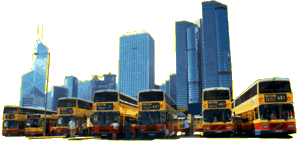|
|
|
|
Buses
|
|
|
|
Citybus started operating buses in 1979 using one double deck bus on a shuttle service for the employees of a Hong
Kong dockyard. By 1981 the Company was operating its first residential bus route between City One Shatin and Kowloon
Tong MTR station. By 1984, Citybus had begun a cross-border coach service between Hong Kong and Shenzhen.
In 1987 the first successful air-conditioned double deckers were put into service on the City One Shatin and cross
border services. Their popularity was so great that additional orders were placed soon afterwards for additional
vehicles to cope with the demand.
In 1991 the Hong Kong Government awarded Citybus its first franchised route on Hong Kong Island, and the Company,
by competitive tender, took over 26 more franchised routes in 1993, followed by a further 14 franchised routes
in 1995.
Success followed success and in 1996 the company won a further competitive tender to operate another 13 prime franchised
routes serving the new Hong Kong International Airport and Tung Chung new town.
An further 12 routes were transferred to the Company in 1998 following the expiry of the franchise of the existing
franchised bus operator on Hong Kong Island.
During this period there has also been expansion in China with a joint venture operation in the China's capital
city, Beijing. Not only was this the capital's first joint venture bus operation, but it also marked the introduction
of air-conditioned buses for the first time. Following the success of this route, a second urban express coach
route was introduced in Beijing.
Over the past two decades, the Company's buses have become a highly popular means for people to commute comfortably
and conveniently between their homes, offices and Hong Kong's major travel interchanges. The Citybus network and
routes now stretch from the south side of Hong Kong Island to Beijing.
Citybus also runs successful contract and private hire services. It provides staff shuttle bus services for organisations
such as Hong Kong Television Broadcasts Limited, air-conditioned shuttle buses from Admiralty to Ocean Park, as
well as a variety of single-deck, double deck and open top buses for private hire.

| The company was established in early 1998 to bid for the franchise to operate public bus services in Hong Kong after the existing franchise, operated by China Motor Bus, expires at the end of August 1998. |
|
Long Win Bus was founded in 1996 by Kowloon Motor Bus. KMB formed this company which would mainly operate bus routes
connecting City, Airport and Tung Chung. Right now, Long Win Bus operate 13 bus routes and owns a small bus fleet
which is supported by KMB. Even all drivers come from KMB. Although KMB and Long Win Bus are different company,
Long Win Bus is like a department of KMB.